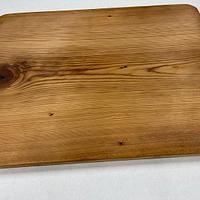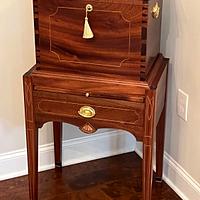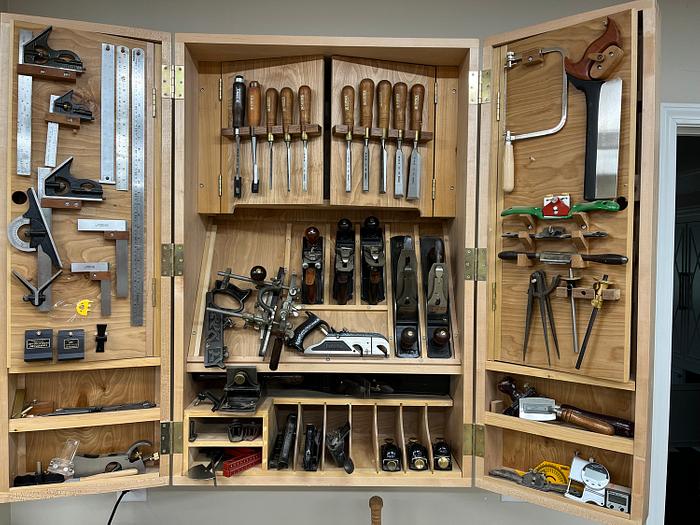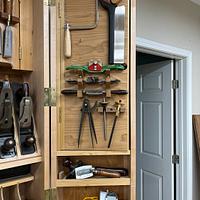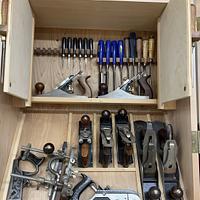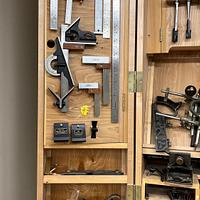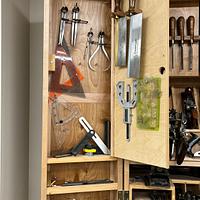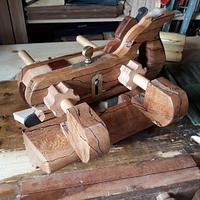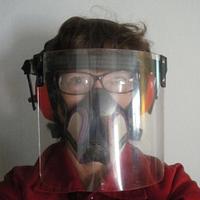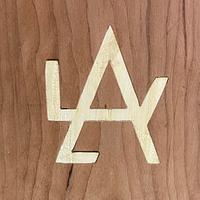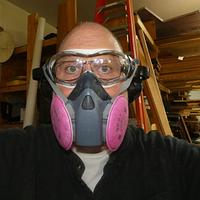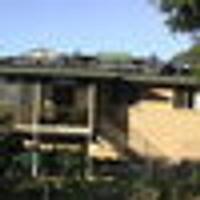
Carey Mitchell
in over 2 years
More from Carey Mitchell
Hanging Tool Cabinet
The dovetails are hand cut. The cabinet and door sides are made from 7/8" maple. Early into the dovetails, I stopped and bought a new set of good quality chisels, spent a day sharpening them and the dovetails became much easier. By the time I finished them, I felt like a pro.
The cabinet is 42 x 28×10 1/2" with doors 4" deep, that adds up to a lot of chisel work.
Both doors house internal doors that double their capacity. The upper section of the cabinet center has internal doors that provide additional storage. Sooo, I added more tools on the backs of the internal doors, and still have some space left.
I used birch plywood for the door panels to give some contrast against the bland maple (good grief - birch plywood from HD ain't what it used to be). I added some character to the front by veneering the door panels with walnut. The finish is satin lacquer.
It is supported on the wall by a french cleat, which is really the 1/2" plywood back. The lower part of the back forms the part attached to the wall, and the upper back is secured to the cabinet. The joint is hidden behind the shelf that supports the plane till. Using the back as the cleat allows a flush fit against the wall. The shelf has through tenons into the sides for extra strength. This thing is heavy !
Some of the antique tools. In the photo, the partially visible Bailey#6 plane lying horizontally on the shelf, and the dividers on the right door belonged to my great grandfather (1857-1952). Also have his 4 ft. level, a spokeshave, a very large brass plumb bob, a wooden clamp and a brace and a bunch of really rusty bits (all on the wall in the photos of the new shop). The Stanley #12 scraper plane on the lower left has the year 1905 engraved (not scratched) on the side, along with the name "C. Schluter, Ballemore 1905" in beautiful script. The Stanley #45 combination plane, with all the 1 1/2 dozen blades, I believe, pre-dates 1919. Though not shown, there are a total of 23 vintage planes that I use constantly. I don't own a modern plane.
I also have a 12 oz. True Temper hammer and a coping saw I got for Christmas when I was 6 - I'm almost 81 now. I used the coping saw to remove waste on the dovetails in this project. I've had them for 75 years and still using both - good quality tools last forever!
If I build another (not likely), I would add 2 inches to the depth of the case to allow the plane till to accept sizes up to #7.
Carey Mitchell
20 Comments
Ryan/// ~sigh~ I blew up another bowl. Moke told me "I made the inside bigger than the outside".
Main Street to the Mountains
Petey
Petey
Your cabinet creates envy! Very nice, well organized, and a great collection of tools.
L/W
“Those who would give up essential Liberty, to purchase a little temporary Safety, deserve neither Liberty nor Safety.” Benjamin Franklin
-- Paul--- Creativity is allowing yourself to make mistakes. Art is knowing which ones to keep. — Scott Adams
It's also great to see someone that is into hand tolls and hasn't gone apeshit trying to acquire/restore all the handtools on this planet.
If your first cut is too short... Take the second cut from the longer end... LBD
daveg, SW Washington & AZ
This was NOT my design. Came from Fine Woodworking, Mike Pekovitch. Detailed drawings, cut list and DVD available.
Carey Mitchell
Norman Pirollo
--Nathan, TX. Hire the lazy man. He may not do as much work but that's because he will find a better way.
Regards Rob
Darrel
If anyone is interested, I have the DVD, the reprint article from FWW and the full size plans, consisting of three 3'x4' sheets printed front and back.
No longer available, only a page size download of the article.
These need a new home. $25 + shipping.
Carey Mitchell









